Flunisolide
FULL PRESCRIBING INFORMATION: CONTENTS*
- FLUNISOLIDE DESCRIPTION
- CLINICAL PHARMACOLOGY
- CLINICAL TRIALS
- INDIVIDUALIZATION OF DOSAGE
- FLUNISOLIDE INDICATIONS AND USAGE
- FLUNISOLIDE CONTRAINDICATIONS
- WARNINGS
- PRECAUTIONS
- FLUNISOLIDE ADVERSE REACTIONS
- OVERDOSAGE
- FLUNISOLIDE DOSAGE AND ADMINISTRATION
- DIRECTIONS FOR USE
- WARNINGS
- HOW SUPPLIED
- PRINCIPAL DISPLAY PANEL - 0.025% BOTTLE LABEL
- PRINCIPAL DISPLAY PANEL - 0.025% CARTON LABEL
FULL PRESCRIBING INFORMATION
FLUNISOLIDE DESCRIPTION
Flunisolide, the active component of flunisolide nasal solution, is an anti-inflammatory glucocorticosteroid with the chemical name: 6α-fluoro-11β,16α,17,21 tetrahydroxypregna-1,4-diene-3,20-dione cyclic 16,17-acetal with acetone, hemihydrate. It has the following chemical structure:
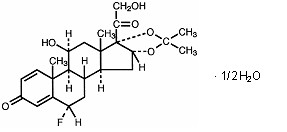
Flunisolide is a white to creamy white crystalline powder with a molecular weight of 443.51 and molecular formula of C24H31FO6. It is soluble in acetone, sparingly soluble in chloroform, slightly soluble in methanol, and practically insoluble in water. It has a melting point of about 245ºC. The octanol:water partition coefficient is 2.17 at neutral pH.
Flunisolide nasal solution is a metered dose manual pump spray unit containing 0.025% w/w flunisolide in an aqueous medium containing benzalkonium chloride, butylated hydroxytoluene, citric acid, edetate disodium, polyethylene glycol 400, polysorbate 20, propylene glycol, sodium citrate, sorbitol and purified water. Sodium hydroxide and/or hydrochloric acid may be added to adjust the pH to 4.5 to 6.0. Each 25 mL spray bottle contains 6.25 mg of flunisolide.
After initial priming (5 to 6 sprays), each spray of the pump spray unit delivers a metered spray of 100 mg formulation containing 29 mcg of flunisolide. The size of 99.5% of the droplets produced by the unit is greater than 8 microns. The contents of one nasal spray bottle delivers 200 sprays in addition to the priming sprays.
CLINICAL PHARMACOLOGY
General Pharmacology
Flunisolide nasal spray has demonstrated potent glucocorticoid and weak mineralocorticoid activity in classical animal test systems. As a glucocorticoid it was 180 times more potent than the cortisol standard in a rat anti-granuloma assay.
Pharmacokinetics
Flunisolide is well absorbed and is rapidly converted by the liver to the much less active primary metabolite and to glucuronide and sulfate conjugates. The primary metabolite results from the loss of the 6α fluorine and addition of a 6β hydroxy group. Following administration of radiolabeled flunisolide to man, approximately half of the label is recovered in the urine and half in the stool. The primary metabolite accounts for 65% to 70% of the amount recovered in the urine. Due to first-pass liver metabolism, only 20% of an oral flunisolide dose reaches the systemic circulation unmetabolized as compared to 50% of an intranasal dose. The plasma half-life of flunisolide is 1 to 2 hours.
In a pharmacokinetic study comparing flunisolide nasal solution (29 mcg per spray) with flunisolide nasal solution (25 mcg per spray), the original formulation, the two formulations were not bioequivalent. The total absorption of flunisolide nasal solution (29 mcg per spray) was 25% less than that of flunisolide nasal solution (25 mcg per spray), and the peak plasma concentration was 30% lower. The clinical significance of these differences is likely to be small, particularly since clinical efficacy is attributable to a local effect on nasal mucosa (see Pharmacodynamics ).
Pharmacodynamics
A study in approximately 100 patients compared control of hay fever symptoms by the recommended dose of flunisolide as flunisolide nasal solution (25 mcg per spray) (200 mcg/day), with control by an oral dose of flunisolide providing equivalent plasma levels. The results demonstrated that the clinical effectiveness was due to the direct topical effect of flunisolide and not to an indirect effect through systemic absorption.
The effects of flunisolide on hypothalamic-pituitary-adrenal (HPA) axis function have been studied in adult volunteers. Flunisolide as flunisolide nasal solution (25 mcg per spray), the original nasal formulation, was administered to 20 subjects intranasally in average total daily doses ranging from approximately 350 mcg to 2200 mcg (equivalent to about 14 to 88 sprays per day) for 4 to 10 days. Early morning plasma cortisol concentrations and 24-hour urinary 17-ketogenic steroids were measured daily. There was no consistent effect on endogenous cortisol production, although evidence of mild adrenal suppression was seen in some subjects.
Controlled studies evaluated adult patients receiving average total daily doses ranging from approximately 50 to 400 mcg (equivalent to about 2 to 16 sprays per day) of flunisolide nasal solution (25 mcg per spray), the original flunisolide nasal spray, for periods as long as 3 months. Three hundred and thirty-nine patients from these studies were entered into a long-term open label study. Morning plasma cortisol levels were available for 182 patients at baseline, 129 after 6 months, and 36 after 12 months of continuous treatment with flunisolide. No effect of flunisolide on cortisol production was detected.
The mechanisms responsible for anti-inflammatory action of corticosteroids and for their effect on the nasal mucosa are not completely understood.
CLINICAL TRIALS
The effectiveness of flunisolide nasal solution was tested in 289 patients for up to 6 weeks at doses up to 300 mcg per day. Flunisolide nasal solution (29 mcg per spray) was shown to be effective in treating the symptoms of allergic rhinitis, including rhinorrhea, nasal congestion and sneezing.
A pivotal, 3-center trial involved 196 patients with seasonal allergic rhinitis randomized to flunisolide nasal solution (25 mcg per spray) the vehicle of flunisolide nasal solution (25 mcg per spray), flunisolide nasal solution (29 mcg per spray) and the vehicle of flunisolide nasal solution (29 mcg per spray). Both active treatments were statistically significantly more effective than the vehicles. There was not statistically significant difference in efficacy between flunisolide nasal solution (25 mcg per spray) and flunisolide nasal solution (29 mcg per spray).
The two formulations do differ, in the nature and incidence of adverse complaints. There were more reports of nasal burning and stinging with flunisolide nasal solution (25 mcg per spray) and more problems related to taste, such as aftertaste, with flunisolide nasal solution (29 mcg per spray), owing to the differences in their respective vehicles. Some patients may prefer one formulation to the other.
INDIVIDUALIZATION OF DOSAGE
The therapeutic effects of corticosteroid nasal sprays, unlike those of decongestants, are not immediate. This should be explained to the patient in advance in order to ensure cooperation and continuation of treatment with the prescribed dosage regimen. Full therapeutic benefit requires regular use and is usually evident within a few days. A longer period of therapy may be required for some patients. However, flunisolide nasal solution should not be continued beyond 3 weeks in the absence of significant symptomatic improvement (see PRECAUTIONS , WARNINGS , Information for Patients and ADVERSE REACTIONS sections).
A starting dose of 2 sprays in each nostril twice daily is recommended. If greater control of symptoms is needed, the dose may be increased to 2 sprays in each nostril 3 times a day. For adults, maximum total daily doses should not exceed 8 sprays in each nostril per day (464 mcg/day).
After the desired clinical effect is obtained, the maintenance dose should be reduced to the smallest amount necessary to control the symptoms. Some patients with perennial rhinitis may be maintained on as little as 1 spray in each nostril per day. It is always desirable to titrate an individual patient to the minimum effective dose to reduce the possibility of side effects.
Flunisolide nasal solution and flunisolide nasal solution (25 mcg per spray), the original flunisolide nasal solution formulation, should not be considered to be identical. Physicians should consider the observed differences in the mean responses in terms of side effects (see ADVERSE REACTIONS ) and flunisolide absorption (see Pharmacokinetics ) in treating individual patients.
For pediatric patients 6 to 14 years of age, the recommended starting dose of flunisolide nasal solution is one spray (29 mcg) in each nostril 3 times a day (total dose 174 mcg/day) or 2 sprays (58 mcg) in each nostril 2 times a day (total dose 232 mcg/day). Maximum daily doses should not exceed 4 sprays in each nostril per day (total dose 232 mcg/day) as the safety and efficacy of higher doses have not been established. Flunisolide nasal solution is not recommended for use in pediatric patients less than 6 years of age as the safety and efficacy have not been assessed in this age group.
FLUNISOLIDE INDICATIONS AND USAGE
Flunisolide nasal solution is indicated for the management of the nasal symptoms of seasonal or perennial rhinitis.
FLUNISOLIDE CONTRAINDICATIONS
Hypersensitivity to any of the ingredients. Flunisolide nasal solution should not be used in the presence of untreated localized infection involving the nasal mucosa.
WARNINGS
The replacement of a systemic corticosteroid with topical corticoid can be accompanied by signs of adrenal insufficiency, and in addition some patients may experience symptoms of withdrawal, e.g., joint and/or muscular pain, lassitude and depression. Patients previously treated for prolonged periods with systemic corticosteroids and transferred to flunisolide nasal solution should be carefully monitored to avoid acute adrenal insufficiency in response to stress.
Careful attention must also be given to patients who have associated asthma or other clinical conditions where too rapid a decrease in systemic corticosteroids may exacerbate their symptoms.
The use of flunisolide nasal solution with systemic prednisone as alternate day therapy or with daily doses of less than 7.5 mg could increase the likelihood of hypothalamic-pituitary-adrenal axis suppression compared to a therapeutic dose of either one alone. Therefore, flunisolide nasal solution treatment should be used with caution in patients already on prednisone regimens for any disease.
Persons who are on drugs which suppress the immune system are more susceptible to infections than healthy individuals. Chicken pox and measles, for example, can have a more serious or even fatal course in nonimmune pediatric patients or adults on corticosteroids. In such pediatric patients or adults who have not had these diseases, particular care should be taken to avoid exposure. How the dose, route and duration of corticosteroid administration affects the risk of developing a disseminated infection is not known. The contribution of underlying disease and/or prior corticosteroid treatment to the risk is also not known. If a nonimmune patient is exposed to chicken pox, prophylaxis with varicella zoster immune globulin (VZIG) may be indicated. If exposed to measles, prophylaxis with pooled intramuscular immunoglobulin (IG) may be indicated. (See the respective package insert for complete VZIG and IG prescribing information). If chicken pox develops, treatment with antiviral agents may be considered.
PRECAUTIONS
General
IIntranasal corticosteroids may also cause a reduction in growth velocity when administered to pediatric patients (see PRECAUTIONS , Pediatric Use section).
Symptomatic relief may not occur in some patients for as long as 2 weeks. Although systemic effects are minimal at recommended doses, flunisolide nasal solution should not be continued beyond 3 weeks in the absence of significant symptomatic improvement. In clinical studies with flunisolide administered intranasally, the development of localized infections of the nose and pharynx with Candida albicans has occurred only rarely. When such an infection develops it may require treatment with appropriate local therapy or discontinuance of treatment with flunisolide nasal solution. Since there is no evidence that exceeding the maximum recommended dose of flunisolide nasal solution is more effective, higher doses should be avoided. Patients should be advised to clear their nasal passages of secretions prior to use. Flunisolide nasal solution should not be used in the presence of untreated local infection involving the nasal mucosa. Flunisolide should be used with caution, if at all, in patients with active or quiescent tuberculosis infection, fungal, bacterial or systemic viral infections or ocular herpes simplex.
As with other nasally inhaled corticosteroids, nasal septal perforations have been reported in rare instances with the use of flunisolide nasal sprays. Temporary or permanent loss of the sense of smell and taste have also been reported with the use of flunisolide nasal sprays.
Because of the inhibitory effect of corticosteroids on wound healing, a nasal corticosteroid should be used with caution in patients who have experienced recent nasal septal ulcers, recurrent epistaxis, nasal surgery or trauma, until healing has occurred. Although systemic corticoid effects typical of Cushing's syndrome are minimal with recommended doses of topical steroids, this potential increases with excessive doses. If recommended doses are exceeded with long-term use, or if individuals are particularly sensitive, symptoms of hypercorticism could occur including suppression of hypothalamic-pituitary-adrenal function and/or retardation of growth in pediatric patients. Therefore, larger than recommended doses of flunisolide nasal solution should be avoided.
Information for Patients
Patients should use flunisolide nasal solution at regular intervals since its effectiveness depends on its regular use. Patients should take the medication as directed and should not exceed the prescribed dose. A decrease in symptoms can be expected to occur within a few days of initiating therapy in allergic rhinitis patients. Patients should contact their physician if the condition worsens, if sneezing or nasal irritation occurs, or if symptoms do not improve by 3 weeks.
Persons taking immunosuppressant doses of corticosteroids should be warned to avoid exposure to chicken pox or measles. Patients should also be advised that if they are exposed, medical advice should be sought without delay.
For proper use of this unit and to attain maximum improvement, the patient should read and follow the accompanying Patient Instructions carefully.
Carcinogenesis
Long-term studies were conducted in mice and rats using oral administration to evaluate the carcinogenic potential of the drug. Flunisolide was administered to mice at doses of 5, 50 and 500 mcg/kg/day (15, 150 and 1500 mcg/m2 respectively), and to rats at doses of 0.5, 1 and 2.5 mcg/kg/day (3.0, 5.9 and 14.8 mcg/m2 respectively). There was an increase in the incidence of benign pulmonary adenomas in mice, but not in rats. Female rats receiving the highest oral dose had an increased incidence of mammary adenocarcinoma compared to control rats. An increased incidence of this tumor type has been reported for other corticosteroids.
Impairment of Fertility
Female rats receiving high doses of flunisolide (200 mcg/kg/day or 1180 mcg/m2 body surface area) showed some evidence of impaired fertility. Reproductive performance in the low (8 mcg/kg/day or 47.2 mcg/m2 and mid-dose (40 mcg/kg/day or 236 mcg/m2) groups was comparable to controls.
Pregnancy
Pregnancy Category C. As with other corticosteroids, flunisolide has been shown to be teratogenic and fetotoxic in rabbits and rats at oral doses of 40 and 200 mcg/kg/day (480 mcg/m2 and 1180 mcg/m2) respectively. There are no adequate and well-controlled studies in pregnant women. Flunisolide should be used during pregnancy only if the potential benefit justifies the potential risk to the fetus.
Nursing Mothers
It is not known whether this drug is excreted in human milk. Because other corticosteroids are excreted in human milk, caution should be exercised when flunisolide is administered to nursing women.
Pediatric Use
Flunisolide nasal solution is not recommended for use in pediatric patients less than 6 years of age as safety and efficacy have not been assessed in this age group. For pediatric patients 6 years of age and over, recommended maximum daily doses should not be exceeded in order to minimize the risk of systemic corticoid effects, including potential growth retardation. (See INDIVIDUALIZATION OF DOSAGE and DOSAGE AND ADMINISTRATION .) Controlled clinical studies have shown that intranasal corticosteroids may cause a reduction in growth velocity in pediatric patients. This effect has been observed in the absence of laboratory evidence of hypothalamic-pituitary-adrenal (HPA) axis suppression, suggesting that growth velocity is a more sensitive indicator of systemic corticosteroid exposure in pediatric patients than some commonly used tests of HPA axis function. The long-term effects of this reduction in growth velocity associated with intranasal corticosteroids, including the impact on final adult height, are unknown. The potential for “catch up” growth following discontinuation of treatment with intranasal corticosteroids has not been adequately studied. The growth of pediatric patients receiving intranasal corticosteroids, including flunisolide nasal solution, should be monitored routinely (e.g., via stadiometry). The potential growth effects of prolonged treatment should be weighed against clinical benefits obtained and the availability of safe and effective noncorticosteroid treatment alternatives. To minimize the systemic effects of intranasal corticosteroids, including flunisolide nasal solution, each patient should be titrated to the lowest dose that effectively controls his/her symptoms.
Geriatric Use
Clinical studies of flunisolide nasal solution did not include sufficient numbers of subjects aged 65 and over to determine whether they respond differently from younger subjects. Other reported clinical experience has not identified differences in responses between the elderly and younger patients. In general, dose selection for an elderly patient should be cautious, usually starting at the low end of the dosing range, reflecting the greater frequency of decreased hepatic, renal, or cardiac function, and of concomitant disease or other drug therapy.
FLUNISOLIDE ADVERSE REACTIONS
The adverse events rates listed below are based on symptoms spontaneously reported in multidose controlled clinical trials in comparing flunisolide nasal solution (29 mcg per spray) and flunisolide nasal solution (25 mcg per spray) for treatment of allergic rhinitis. In patients receiving flunisolide nasal solution the most common adverse events were transient aftertaste (17%) and transient nasal burning and stinging (13%). These symptoms did not usually interfere with treatment.
Adverse Event Rates for Flunisolide Nasal Solution (29 mcg per spray)
Incidence Greater than 1% (probably casually related)
Respiratory: Nasal burning/stinging (13%), epistaxis*, nasal dryness, pharyngitis, cough increased
Gastrointestinal: Nausea
Special Senses: Aftertaste (17%)
Incidence 1% or Less (probably casually related)
Respiratory: Hoarseness
Special Senses: Abnormal sense of smell
Incidence 1% or Less (casual relationship unknown)
Respiratory: Sinusitis
Adverse Event Rates for Flunisolide Nasal Solution (25 mcg per spray)
Incidence Greater than 1% (probably casually related)
Respiratory: Nasal burning/stinging (44%), epistaxis*, nasal dryness*, pharyngitis*, cough increased
Gastrointestinal: Nausea
Special Senses: Aftertaste (8%)
Incidence 1% or Less (probably casually related)
Respiratory: Hoarseness, nasal ulcer
Incidence 1% or Less (casual relationship unknown)†
Respiratory: Sinusitis
Cases of growth suppression have been reported for intranasal corticosteroids (including flunisolide nasal solution) (see PRECAUTIONS , Pediatric Use section).
* Incidence of reported reaction between 3% and 9%. Those reactions occurring in less than 3% of the patients
† Reactions occurred under circumstances where the casual relationship has not been clearly established; they are presented as alerting information for physicians
OVERDOSAGE
In mice, rats and dogs, intravenous flunisolide at doses up to 4 mg/kg showed no effect. One spray bottle contains 6.25 mg of flunisolide; therefore, acute overdosage is unlikely.
FLUNISOLIDE DOSAGE AND ADMINISTRATION
For adults, the recommended starting dose of flunisolide nasal solution is 2 sprays (58 mcg) in each nostril 2 times a day (total dose 232 mcg/day): the effect should be assessed in 4 to 7 days (see INDIVIDUALIZATION OF DOSAGE section). Some relief can be expected in approximately two-thirds of patients within that time. This dose may be increased to 2 sprays in each nostril 3 times a day (total dose 348 mcg/day) if greater effect is needed. For adults, maximum total daily doses should not exceed 8 sprays in each nostril per day (464 mcg/day). After the desired clinical effect is obtained, the maintenance dose should be reduced to the smallest amount necessary to control the symptoms (See INDIVIDUALIZATION OF DOSAGE section).
For pediatric patients 6 to 14 years of age, the recommended starting dose of flunisolide nasal solution is one spray, (29 mcg) in each nostril 3 times a day (total dose 174 mcg/day) or 2 sprays (58 mcg) in each nostril 2 times a day (total dose 232 mcg/day). For pediatric patients 6 to 14 years of age, maximum daily doses should not exceed 4 sprays in each nostril per day (total dose 232 mcg/day) as the safety and efficacy of higher doses have not been established.
Flunisolide nasal solution is not recommended for use in pediatric patients less than 6 years of age as safety and efficacy, including possible adverse effects on growth, have not been assessed in this age group.
For priming and repriming of nasal spray unit after storageThe patient should remove the protective cap. Put two fingers on the “shoulders” and thumb on the bottom of the bottle. Push the bottle with your thumb FIRMLY and QUICKLY 5-6 times or until a fine mist appears. Now your preset pump is primed. The patient must prime the preset pump unit again if it has not been used for 5 days or more, or if it has been disassembled for cleaning.
Flunisolide nasal solution (29 mcg per spray) and flunisolide nasal solution (25 mcg per spray) should not be considered to be identical products. Physicians should consider the observed differences in the mean responses in terms of side effects (see ADVERSE REACTIONS ) and flunisolide absorption (see Pharmacokinetics ) in treating individual patients.
DIRECTIONS FOR USE
A patient leaflet of instructions accompanies each package of Flunisolide Nasal Solution USP, 0.025% (Nasal Spray).
WARNINGS
Do not spray in eyes
HOW SUPPLIED
Each 25 mL of Flunisolide Nasal Solution USP, 0.025% (Nasal Spray) (6.25 mg flunisolide) is supplied in a white, HDPE bottle fitted with a metered nasal spray pump, white actuator and a clear protective cap (NDC 60505-0824-0). The unit contains 200 metered sprays and comes with a patient instruction leaflet. Store at 20° to 25°C (68° to 77°F) [see USP Controlled Room Temperature].
Manufactured by: Manufactured for:
Apotex Inc. Apotex Corp.
Toronto, Ontario Weston, FL 33326
Canada M9L 1T9
289770 May 2006
Patient Instructions
Rx Only
Flunisolide Nasal Solution USP, 0.025% (Nasal Spray)
(29 mcg flunisolide per spray)
Note: Not identical to the 25 mcg flunisolide per spray
Nasal Spray Unit With the Preset (Preassembled) Pump
Your flunisolide nasal solution nasal spray unit with the pump is already assembled. Please follow the directions below to prepare it for your use.
IMPORTANT INFORMATION ON FLUNISOLIDE NASAL SOLUTION USP, 0.025% (NASAL SPRAY):
-
You should use Flunisolide Nasal Solution USP, 0.025% (Nasal Spray) at regular intervals as directed since is effectiveness depends on its regular use (see below).
-
It may take 1-2 weeks before full relief is obtained.
-
You should contact your physician if symptoms do not improve, if the condition worsens, or if sneezing, nasal irritation, or bleeding occurs.
-
You should contact your physician if you know you have been exposed to chicken pox or measles.
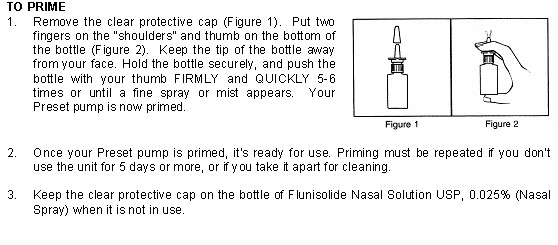
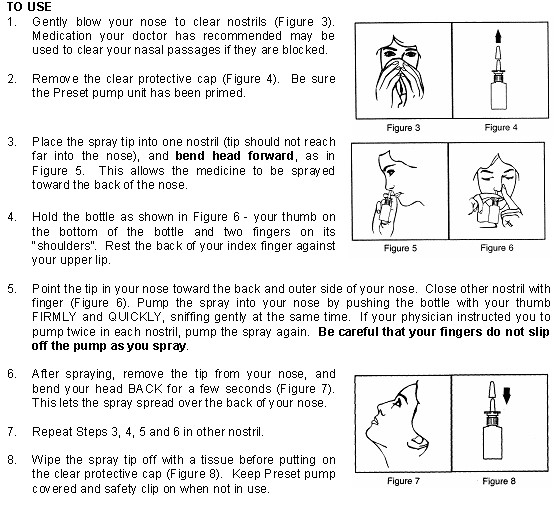

Manufactured by: Manufactured for:
Apotex Inc. Apotex Corp.
Richmond Hill, Ontario Weston, FL 33326
Canada L4C 5H2
289770 May 2006
PRINCIPAL DISPLAY PANEL - 0.025% BOTTLE LABEL
Representative sample of labeling (see HOW SUPPLIED section for complete listing):
APOTEX CORP. NDC 60505-0824-0
Flunisolide Nasal Solution USP, 0.025%
(Nasal Spray)
(29 mcg flunisolide per spray)
For Intranasal Use Only
0.25%
Rx
200 Metered Sprays
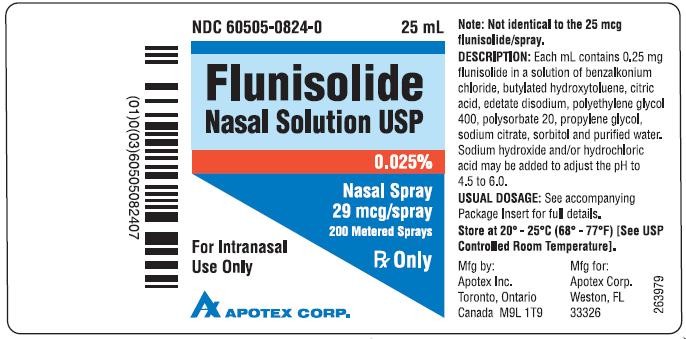
PRINCIPAL DISPLAY PANEL - 0.025% CARTON LABEL
Representative sample of labeling (see HOW SUPPLIED section for complete listing):
APOTEX CORP. NDC 60505-0824-0
Flunisolide Nasal Solution USP, 0.025%
(Nasal Spray)
(29 mcg flunisolide per spray)
For Intranasal Use Only
0.25%
Rx
200 Metered Sprays
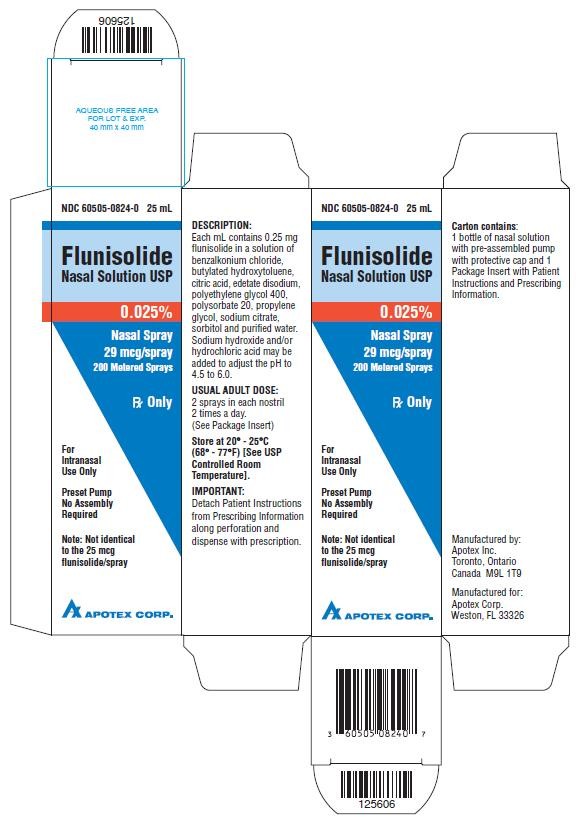
FlunisolideFlunisolide SPRAY, METERED
| |||||||||||||||||||||||||||||||||||||||||||||||||||||||||||||||||||||||||||||||||||